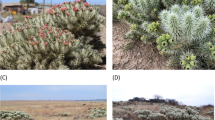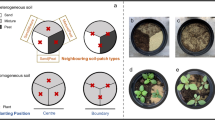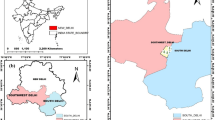Abstract
We evaluate the mechanisms that determine the establishment of the non-indigenous shrub Pyracantha coccinea (Rosaceae) in the Montpellier region of southern France. P. coccinea establishes in abandoned agricultural fields in this region; yet, despite its high propagule pressure, it has not become a widespread invasive. We hypothesized that the disturbance conditions prevailing in abandoned agricultural fields right after abandonment may enhance the emergence, survival and growth of P. coccinea, but that shortly after abandonment colonizing vegetation prevents further establishment of this species. We conducted a field experiment to evaluate this hypothesis, studying the response of seedling emergence and growth of P. coccinea to soil and vegetation disturbance. Our results show that both lack of vegetation cover and soil disturbance promote the emergence of seedlings of P. coccinea. Thus, the disturbance conditions prevailing in abandoned agricultural fields seem crucial to allow establishment of this species. However, other factors such as lack of summer dormancy and seed predation might explain why this species has not become a widespread invasive.
Similar content being viewed by others
References
Alpert P, Bone E, Holzapfel C (2000) Invasiveness, invasibility, and the role of environmental stress in preventing the spread of non-native plants. Perspect Plant Ecol Evol Syst 3:52–66
Alston KP, Richardson DM (2006) The roles of habitat features, disturbance, and distance from putative source populations in structuring alien plant invasions at the urban/wildland interface on the Cape Peninsula, South Africa. Biol Conserv 132:183–198
Baeza MJ, Vallejo VR (2006) Ecological mechanisms involved in dormancy breakage in Ulex parviflorus seeds. Plant Ecol 183:191–205
Bartha S, Meiners SJ, Pickett STA, Cadenasso ML (2003) Plant colonization windows in a mesic old field succession. Appl Veg Sci 6:205–212
Burke MJW, Grime JP (1996) An experimental study of plant community invasibility. Ecology 77:776–790
Chytry M, Pysek P, Wild J, Pino J, Maskell LC, Vila M (2009) European map of alien plant invasions based on the quantitative assessment across habitats. Divers Distrib 15:98–107
Debussche M (1985) Rôle des oiseaux disséminateurs dans la germination des graines de plantes à fruits charnus en région méditerranéenne. Acta Oecol 6:365–374
Debussche M, Escarré J (1983) Carte des isohyètes inter-annuelles dans le montpelliérais. Document établi pour la série 1950–1979 (avec pour certaines stations les valeurs de S, m, M, et Q2). Carte couleurs 320x340, 1/300.000. CEPE/CNRS, Montpellier
Debussche M, Isenmann P (1990) Introduced and cultivated fleshy-fruited plants: consequences of a mutualistic Mediterranean plant-bird system. In: di Castri F, Hansen AJ, Debussche M (eds) Biological invasions in Europe and the Mediterranean basin. Kluwer, Dordrecht, pp 399–416
Debussche M, Isenmann P (1994) Bird-dispersed seed rain and seedling establishment in patchy Mediterranean vegetation. Oikos 69:414–426
Debussche M, Lepart J (1992) Establishment of woody plants in Mediterranean old fields: opportunity in space and time. Landscape Ecol 6:133–145
Di Castri E (1989) History of biological invasions with special emphasis on the old world. In: Drake JA, Mooney HA, di Castri F, Groves RH, Kruger FJ, Rejmanek M, Williamson M (eds) Biological invasions: a global perspective. Wiley, Chichester, pp 1–30
Elton CS (1958) The ecology of invasions by animals and plants. The University of Chicago Press, Chicago
García D, Obeso JR (2003) Facilitation by herbivore-mediated nurse plants in a threatened tree, Taxus baccata: local effects and landscape level consistency. Ecography 26:739–750
Goldberg DE, Gross KL (1988) Disturbance regimes of midsuccessional old fields. Ecology 69:1677–1688
Grau HR, Aragón R (2000) Árboles invasores de la Sierra de San Javier, Tucumán, Argentina. In: Grau HR, Aragón R (eds) Ecología de árboles exóticos en las Yungas argentinas. LIEY, Tucumán
Herrera CM (1984) A study of avian frugivores, bird-dispersed plants, and their interaction in Mediterranean scrublands. Ecol Monogr 54:1–23
Herrera CM (1992) Historical effects and sorting processes as explanations for contemporary ecological patterns–character syndromes in Mediterranean woody plants. Am Nat 140:421–446
Hierro JL, Villarreal D, Eren O, Graham JM, Callaway RM (2006) Disturbance facilitates invasion: the effects are stronger abroad than at home. Am Nat 168:144–156
Hobbs RJ (1989) The nature and effects of disturbance relative to invasions. In: Drake JA, Mooney HA, di Castri F, Groves RH, Kruger FJ, Rejmanek M, Williamson M (eds) Biological invasions: a global perspective. Wiley, Chichester, pp 389–405
Hobbs RJ (1991) Disturbance a precursor to weed invasion in native vegetation. Plant Prot Quart 6:99–104
Jordano P, Bascompte J, Olesen JM (2003) Invariant properties in coevolutionary networks of plant–animal interactions. Ecol Lett 6:69–81
Karlsson LM, Hidayati SN, Walk JL, Milberg P (2005) Complex combination of seed dormancy and seedling development determine emergence of Viburnum tinus (Caprifoliaceae). Ann Bot 95:323–330
Lavorel S, Debussche M, Lebreton JD, Lepart J (1993) Seasonal patterns in the seed bank of Mediterranean old-fields. Oikos 67:114–128
Lonsdale WM (1999) Global patterns of plant invasions and the concept of invasibility. Ecology 80:1522–1536
Lozon JD, MacIsaac HJ (1997) Biological invasions: are they dependent on disturbance? Environ Rev 5:131–144
Maguire JD (1962) Speed of germination-aid in selection and evaluation for seedling emergence and vigor. Crop Sci 2:176–177
Malric C (2004) Inventaire, Cartographie et Proposition de Gestion des Plantes Envahissantes sur la Commune de Lattes. Agence Méditerranéenne de l’Environnement. http://www.ame-lr.org/publications/index.html
Maron JL, Vilá M (2001) When do herbivores affect plant invasion? Evidence for the natural enemies and biotic resistance hypotheses. Oikos 95:361–373
Myers JH, Bazely D (1999) Ecology and control of introduced plants. Cambridge University Press, Cambridge
Nuñez MA, Simberloff D, Relva MR (2008) Seed predation as a barrier to alien conifer invasions. Biol Invasions 10:1389–1398
Olmez Z, Temel F, Gokturk A, Yahyaoglou Z (2007) Effect of cold stratification treatments on germination of drought tolerant shrubs seeds. J Environ Biol 28:447–453
Oukabli A, Mahhou A (2007) Dormancy in sweet cherry (Prunus avium L.) under Mediterranean climatic conditions. Biotechnol Agron Soc Environ 11:133–139
Prieur-Richard A-H, Lavorel S (2000) Invasions: the perspective of diverse plant communities. Austral Ecol 25:1–7
Rejmánek M (2000) Invasive plants: approaches and predictions. Austral Ecol 25:497–506
Richardson DM, Pyšek P, Barbour MG, Panetta FD, West CJ (2000) Naturalization and invasion of alien plants: concepts and definitions. Divers Distrib 6:93–107
Schültz C (1999) Dormancy prevents seeds from germinating in the hot, dry season. Physiol Plant 73:368–373
Shea K, Chesson P (2002) Community ecology theory as a framework for biological invasions. Trends Ecol Evol 17:170–176
Tilman D (1993) Species richness of experimental productivity gradients: how important is colonization limitation? Ecology 74:2179–2191
Von Holle B, Delcourt H, Simberloff D (2003) Biological inertia and its application in studies of ecological resistance to invasion. J Veg Sci 14:425–432
Acknowledgments
We thank Annabelle Dossantos and Juan del Río for help with experimental work, and Daniel Simberloff, Martín Nuñez and anonymous referees for valuables comments on the manuscript. AEV was supported by SGCyT, Universidad Nacional del Sur, Argentina. DPV was supported during the initial part of this work through a visiting scientist fellowship at the Centre d’Écologie Fonctionnelle et Evolutive of the CNRS, France.
Author information
Authors and Affiliations
Corresponding author
Rights and permissions
About this article
Cite this article
de Villalobos, A.E., Vázquez, D.P. & Martin, JL. Soil disturbance, vegetation cover and the establishment of the exotic shrub Pyracantha coccinea in southern France. Biol Invasions 12, 1023–1029 (2010). https://doi.org/10.1007/s10530-009-9519-z
Received:
Accepted:
Published:
Issue Date:
DOI: https://doi.org/10.1007/s10530-009-9519-z




